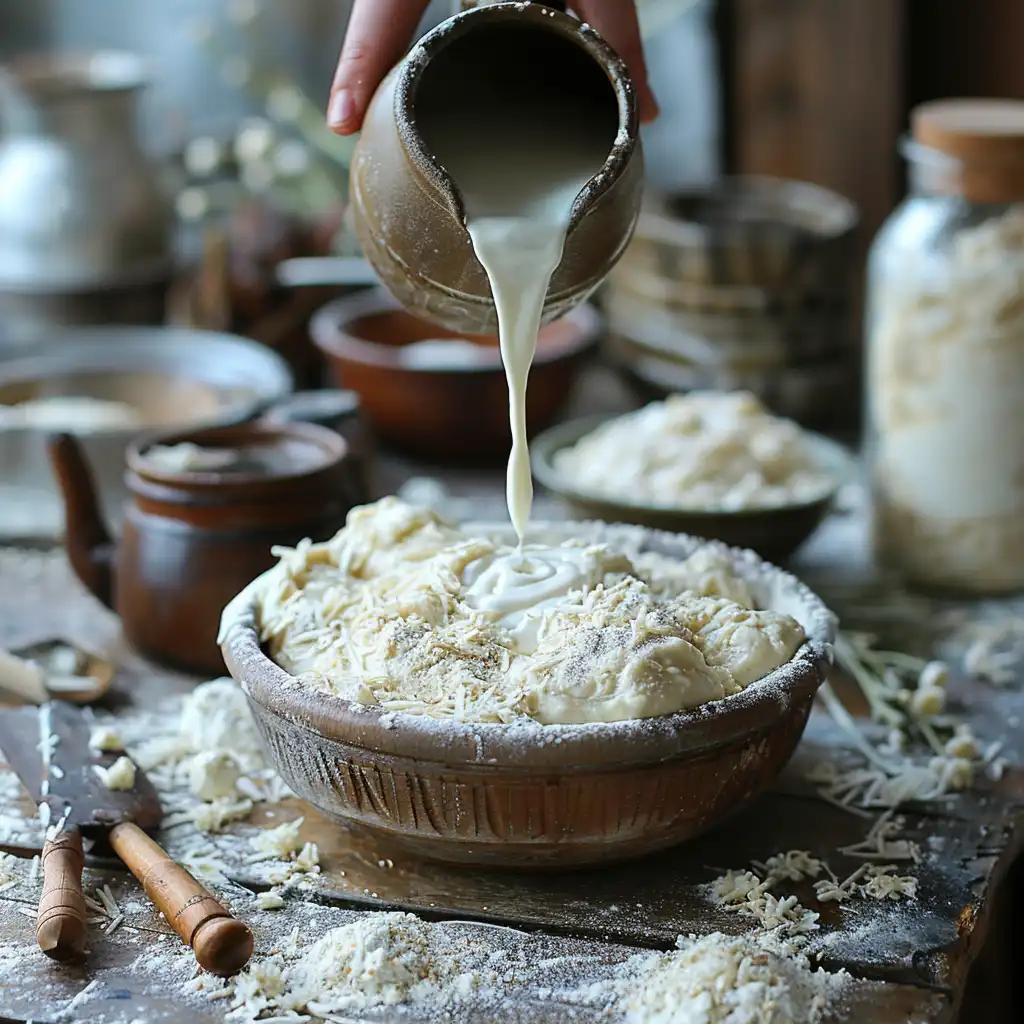Bread baking is an age-old tradition, but even the most experienced bakers love experimenting with new ingredients to improve texture, taste, and nutrition. One such ingredient is yogurt, a versatile and healthful addition to bread recipes. But what does adding yogurt to bread do? In this article, we’ll uncover the science, benefits, and practical applications of yogurt in bread making. From creating softer loaves to boosting flavor and extending shelf life, yogurt’s role in bread is nothing short of transformative. Let’s dive in!
Part 1: Understanding the Role of Yogurt in Bread Making
What is Yogurt and Why is it Used in Bread Recipes?
Yogurt, a fermented dairy product, is rich in proteins, fats, and natural acids, making it a unique addition to bread recipes. Its tangy flavor and creamy texture can elevate ordinary loaves to bakery-worthy creations. Many bakers turn to yogurt because it’s a natural, healthy alternative to other dairy products like milk or cream. Not only does it add a subtle zing to the bread, but it also enriches the dough with essential nutrients like calcium and probiotics.
The magic of yogurt lies in its ability to transform dough. The combination of natural acidity and protein content helps to condition the dough, resulting in a more elastic and pliable texture. This makes it easier to knead and shape the bread. Whether you’re crafting a rustic loaf or a soft dinner roll, yogurt works wonders in fine-tuning the dough’s quality.
Key Properties of Yogurt That Affect Dough Texture and Flavor
Let’s talk about the properties that make yogurt a baker’s best friend. First and foremost, its acidic nature plays a critical role. The acidity strengthens the dough’s gluten structure, giving the bread a chewier, more robust texture. At the same time, the fats and proteins in yogurt add a luscious richness to the crumb.
When it comes to flavor, yogurt provides a subtle tanginess that complements both sweet and savory breads. This flavor-enhancing property is why many traditional recipes—like flatbreads and sourdoughs—call for yogurt. It’s a natural flavor booster that doesn’t overpower the other ingredients.
Additionally, yogurt contains moisture-retaining qualities. As a result, bread made with yogurt stays soft and fresh longer compared to bread made with just water or milk.
How Yogurt Interacts with Other Ingredients Like Yeast and Flour
When you add yogurt to bread dough, its interaction with other ingredients like yeast and flour becomes key to achieving the perfect loaf. The acids in yogurt can improve yeast fermentation, providing an optimal environment for yeast to thrive. This results in a better rise and a more aerated crumb.
Moreover, yogurt interacts with the flour’s gluten proteins, enhancing elasticity and creating a dough that is easier to handle. This is particularly beneficial for novice bakers who may struggle with tough or sticky dough. By balancing the hydration levels and gluten development, yogurt makes the bread-baking process smoother and more forgiving.
Finally, yogurt’s fats and proteins contribute to the overall structure of the bread. They provide stability during baking, ensuring that the loaf holds its shape while developing a golden-brown crust.
Part 2: Benefits of Adding Yogurt to Bread Dough
Enhanced Moisture and Soft Texture in Bread
One of the standout benefits of adding yogurt to bread dough is its ability to make the bread incredibly moist and tender. The natural fats and proteins in yogurt bind with the flour, creating a softer crumb. This is especially valuable for loaves that are meant to stay fresh longer or have a pillowy texture. Unlike water or milk, yogurt contributes a creaminess that remains even after baking, giving the bread a melt-in-your-mouth quality.
Additionally, yogurt’s ability to lock in moisture ensures that the bread doesn’t dry out quickly. For example, recipes like Greek yogurt garlic bread, as featured on Tasty Fables, showcase how yogurt can create golden, soft loaves perfect for any meal.
Improved Fermentation and Bread Flavor Profile
Another key benefit of yogurt is its ability to enhance fermentation. The acidity in yogurt supports yeast activity by lowering the pH of the dough, fostering better fermentation. This leads to a lighter, airier crumb structure and a more pronounced rise during baking. Bread made with yogurt often develops a complex, tangy flavor that’s deeply satisfying, whether used for savory sandwiches or sweet breakfast toast.
This improved flavor profile is why many bakers opt for yogurt in sourdough and other artisanal breads. It’s also a great way to introduce unique tastes into everyday loaves, making each bite flavorful and rich.
Nutritional Advantages of Using Yogurt in Bread
From a health perspective, yogurt adds more than just taste and texture. It’s rich in calcium, probiotics, and vitamins that can make your bread a source of extra nutrition. These nutrients are especially beneficial in whole-grain breads, where yogurt can balance the heavier texture with added softness.
Incorporating yogurt into recipes like flatbreads or banana loaves also creates a healthier alternative to recipes relying heavily on butter or cream. For instance, the Pumpkin Banana Loaf recipe on Tasty Fables demonstrates how yogurt can transform baked goods into nutritious yet indulgent treats.
Extending Bread Shelf Life Through Yogurt Addition
Bread made with yogurt tends to stay fresher for longer. The natural acidity in yogurt acts as a mild preservative, preventing the bread from becoming stale quickly. This is a game-changer for home bakers looking to extend the life of their homemade loaves without relying on artificial preservatives.
Moreover, the moisture-retaining properties of yogurt ensure that even on the second or third day, your bread feels just as soft as when it came out of the oven. Whether you’re baking for a family gathering or meal prepping for the week, yogurt can help your bread stay at its best.
Part 3: Step-by-Step Guide to Adding Yogurt to Bread Recipes

How to Measure and Incorporate Yogurt in Recipes
Adding yogurt to bread recipes might seem straightforward, but precise measurements are key to achieving the best results. As a general rule, substitute half of the liquid in the recipe with yogurt. For example, if a recipe calls for 1 cup of water, use ½ cup of water and ½ cup of yogurt. This ensures the dough maintains the right balance of moisture and structure.
When mixing yogurt into the dough, make sure it’s evenly distributed. Using a stand mixer or a whisk can help achieve a smooth consistency, reducing the chance of lumps. For those new to baking, starting with a simple recipe like Greek yogurt garlic bread from Tasty Fables is a fantastic way to practice.
Substituting Yogurt for Other Liquids in Bread Dough
Yogurt can easily replace other liquids in bread dough, such as milk, cream, or even buttermilk. However, it’s essential to adjust the consistency based on the type of yogurt you’re using. Greek yogurt, for example, is thicker than regular yogurt and may require you to add a small amount of water to achieve the desired dough texture.
When substituting yogurt for milk, keep in mind that yogurt adds a tangy flavor, which can beautifully complement savory breads but might require balancing with additional sweeteners in dessert loaves.
Common Mistakes to Avoid When Using Yogurt in Bread Baking
Even with its many benefits, there are some pitfalls to avoid when adding yogurt to bread recipes:
- Using too much yogurt: Excess yogurt can make the dough too sticky or dense, making it difficult to knead and shape.
- Skipping adjustments for thickness: Different yogurts have varying water content, so failing to adjust can lead to inconsistent results.
- Ignoring temperature compatibility: Always bring yogurt to room temperature before adding it to the dough. Cold yogurt can inhibit yeast activation, leading to poor fermentation.
By avoiding these common mistakes, you can fully harness the potential of yogurt to create exceptional bread.
Part 4: Popular Bread Recipes Incorporating Yogurt

Traditional Yogurt Flatbreads
Yogurt has been a staple ingredient in flatbread recipes for centuries, especially in Mediterranean and Middle Eastern cuisines. The addition of yogurt creates soft, pliable dough that’s easy to roll out and perfect for grilling or baking. Flatbreads like naan or pita bread owe their tender texture and slightly tangy flavor to yogurt.
To make your own yogurt flatbread, simply combine flour, yogurt, baking powder, and a pinch of salt to create a quick and versatile dough. Whether you’re making wraps, dipping bread, or even mini pizzas, yogurt flatbreads are a crowd-pleaser. For more inspiration, you can explore unique yogurt-based recipes like the Greek Yogurt Garlic Bread featured on Tasty Fables.
Yogurt-Enriched Sourdough Bread
For sourdough enthusiasts, adding yogurt to your starter or dough can enhance its tangy flavor and improve its texture. Yogurt complements the natural fermentation process of sourdough, boosting its rise and crumb structure. Plus, the acidity of yogurt strengthens gluten development, making the bread more elastic and easier to shape.
A great tip is to use yogurt when refreshing your sourdough starter. Replace a portion of the water with yogurt to give your bread an extra depth of flavor. It’s an excellent way to experiment with sourdough baking and answer the question what does adding yogurt to bread do?—it elevates your loaves to new heights!
Sweet Breads Made with Yogurt (Cakes and Loaves)
Yogurt isn’t just for savory bread; it also works wonders in sweet breads like banana bread, cinnamon loaves, or even breakfast muffins. Its creamy texture and tangy flavor balance out sweetness while keeping the bread moist for days. Recipes like the Pumpkin Banana Loaf on Tasty Fables are perfect examples of how yogurt can make sweet breads richer and more flavorful.
For sweet bread recipes, try swapping out milk or buttermilk for yogurt. You’ll notice a difference in the bread’s tenderness and a subtle complexity in its flavor.
Part 5: Science Behind Yogurt’s Impact on Bread Texture and Rise
The Role of Yogurt’s Acidity in Dough Strengthening
The acidity in yogurt is one of the key factors that improve bread dough. By lowering the dough’s pH, yogurt strengthens the gluten network, which gives bread its structure. This is why bread made with yogurt often has a chewier, more resilient texture. For breads like sourdough or artisan-style loaves, this characteristic is especially desirable.
Additionally, the acidic environment created by yogurt enhances the activity of natural or added yeast, resulting in a better rise and a more uniform crumb. If you’ve ever wondered what does adding yogurt to bread do?, the answer lies in this scientific interaction that transforms the dough.
How Yogurt Proteins Contribute to Bread Crumb Formation
Proteins in yogurt, such as casein, interact with the gluten in flour to improve crumb structure. This interaction helps create a bread that’s not only soft but also has a desirable elasticity. As the bread bakes, these proteins provide additional support, preventing the loaf from collapsing and ensuring a balanced rise.
This is particularly useful in recipes like Greek Yogurt Garlic Bread, where a soft yet sturdy texture is essential for holding toppings or spreads.
Exploring the Effects of Yogurt’s Fats on Crust and Texture
The fats in yogurt contribute to both the crust and crumb of the bread. During baking, these fats help create a beautifully browned crust, while also ensuring the interior stays tender. The result is bread that’s both visually appealing and delicious.
For those experimenting with yogurt in bread baking, it’s worth noting how even small amounts of fat can change the bread’s overall texture. This balance of crisp crust and soft interior is what makes yogurt an indispensable ingredient for many bakers.
If you’re curious about more ways to incorporate yogurt into your baking, don’t hesitate to explore Tasty Fables for additional recipes and tips. From flatbreads to banana loaves, yogurt truly elevates the art of bread-making!
Part 6: FAQs About Using Yogurt in Bread Making
Can You Use Flavored Yogurt in Bread Dough?
Yes, you can use flavored yogurt in bread dough, but it depends on the recipe. For example, flavored yogurts like vanilla or fruit-based varieties work well in sweet bread recipes such as banana loaves or muffins. However, for savory breads, it’s best to stick with plain yogurt to avoid clashing flavors.
Adding flavored yogurt not only enhances the sweetness but also introduces subtle notes of its flavor to the bread. This can create unique taste profiles for desserts or breakfast breads. So, when you’re asking what does adding yogurt to bread do?, remember that even flavored yogurt can add moisture, tanginess, and a touch of sweetness to your baked goods.
What Type of Yogurt is Best for Bread Recipes?
When baking bread, plain yogurt or Greek yogurt is often the best choice. Greek yogurt is thicker and creamier, making it ideal for recipes that require a denser dough, such as naan or sourdough. On the other hand, regular yogurt is lighter and has more liquid, which works better in softer, more elastic bread recipes.
Whichever you choose, make sure it’s unsweetened to give you better control over the recipe’s flavor profile. Always bring the yogurt to room temperature before adding it to the dough, as this ensures smooth incorporation and activates the yeast effectively.
How Does Yogurt Compare to Other Dairy Additives?
Yogurt stands out among dairy additives because of its unique combination of acidity, fats, and proteins. Unlike milk or cream, yogurt adds a tangy flavor that enhances both sweet and savory recipes. Its acidity also strengthens gluten development, which isn’t typically achieved with milk alone.
Compared to buttermilk, yogurt has a creamier texture and contributes more moisture, which can be a game-changer for softer breads. These properties are what make yogurt a go-to choice for bakers looking for versatile dairy alternatives.
Can Yogurt Replace All Liquids in a Recipe?
While yogurt can replace some liquids in bread dough, it’s best not to replace all of them. Bread dough needs the right balance of hydration and structure, which is why yogurt is often combined with water, milk, or other liquids.
Replacing too much liquid with yogurt can make the dough overly dense or difficult to handle. As a rule of thumb, substitute no more than half of the liquid in a recipe with yogurt. For instance, if your recipe calls for 1 cup of liquid, try using ½ cup of yogurt and ½ cup of water to maintain the dough’s balance.
Part 7: Conclusion and Final Thoughts
Why Yogurt is a Game-Changer in Bread Baking
Yogurt is a transformative ingredient that improves every aspect of bread baking. From enhancing texture and flavor to boosting moisture and nutrition, it’s no wonder bakers frequently ask, what does adding yogurt to bread do? This simple addition makes bread softer, tastier, and fresher for longer.
Whether you’re crafting artisan sourdough or whipping up quick flatbreads, yogurt provides a unique blend of proteins, fats, and acidity that elevate the quality of your bread. By incorporating yogurt into your recipes, you’ll not only improve your baking skills but also enjoy loaves that are consistently delicious.
Tips for Trying Yogurt in Your Next Bread Recipe
Ready to experiment with yogurt in your next loaf? Start small by substituting part of the liquid in a familiar recipe with yogurt. Pay attention to how the dough feels and adjust as needed. Use Greek yogurt for a thicker, richer crumb, or regular yogurt for a lighter texture.
For those looking to explore more yogurt-based recipes, don’t forget to check out creative ideas like Pumpkin Banana Loaf or Greek Yogurt Garlic Bread from Tasty Fables. These recipes showcase how yogurt can transform traditional breads into extraordinary creations.
So, grab your favorite yogurt, fire up the oven, and start baking your way to softer, more flavorful bread!

